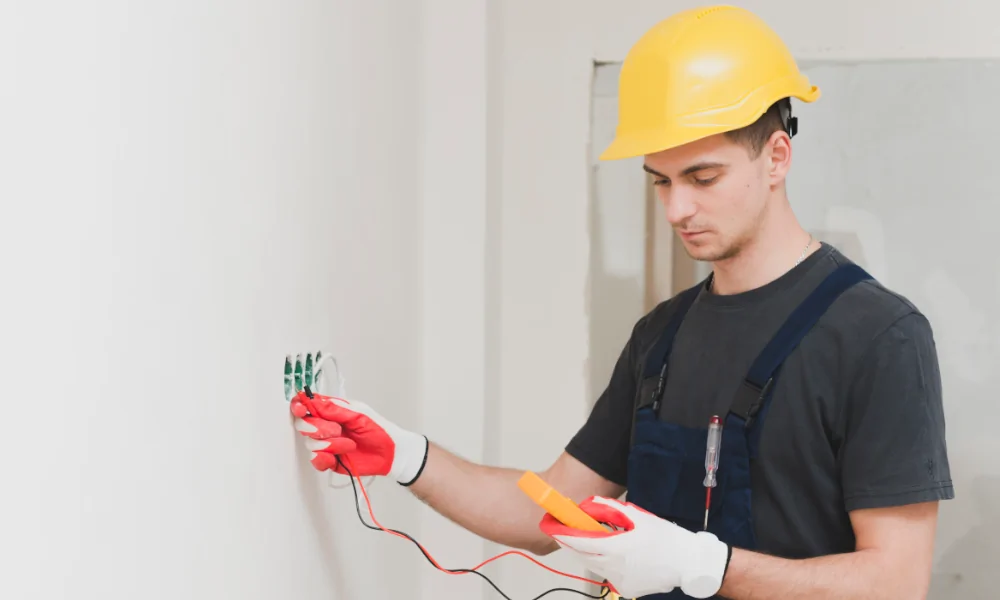Ensuring your home or rented property’s electrical safety should be first-and-foremost of everyone’s to-do list! Faulty wiring can pose a serious risk of fire and electric shock, and could even put you in breach of the law with regards to tenants in your property, if you are a landlord. That’s why it’s crucial to have your electrics inspected regularly. In this article, we’ll answer the question we’re most commonly asked here at J Clail, “how often should electrical installations be tested?”
What is electrical testing?
Electrical testing is the process of a qualified electrician inspecting and testing your property’s electrical system. This ensures everything is in safe working order and meets safety regulations! There are various tests performed during an electrical inspection, including:
- Visual inspection: Checking for damaged or worn wiring, overloaded circuits, and loose connections.
- Earth fault loop impedance test: This test verifies the effectiveness of your earthing system, which is crucial for preventing electric shock.
- Polarity testing: Ensures live, neutral, and earth conductors are connected correctly.
- Insulation resistance testing: Measures the insulation quality of cables to identify potential weaknesses.
If you’re renting a property, you may also be required to have:
Portable Appliance Testing (PAT): PAT testing is the inspection of portable electrical appliances to ensure their safety. This is typically not part of an electrical inspection but is a separate service offered by qualified electricians.
Electrical Installation Condition Report (EICR): This test details the findings of the electrical inspection, highlighting any issues identified and providing recommendations for any remedial work. This test will then be summarised in a report providing an overall health of the building. If you’re a landlord, you must have an EICR as of April 2021.
What does an electrical testing check for?
The electrical testing identifies a range of potential problems, including:
- Faulty wiring
- Overloaded circuits
- Earthing issues
- Loose connections
- Damaged electrical components
These problems can lead to fires, electric shocks, and appliance malfunctions. Regular testing helps prevent these dangers and ensures your electrical systems function safely and efficiently!
How often should electrics be tested?
The recommended frequency for electrical testing depends on the type of property:
For homeowners: The general recommendation is to have your electrics tested every 10 years. However, more frequent inspections may be necessary if you have an older property, extensive electrical work has been done, or you notice any warning signs like flickering lights or burning smells.
For landlords: In England and Wales, it’s a legal requirement for landlords to have an electrical inspection carried out on their rental properties every five years, or between each tenant. This ensures the safety of tenants and helps meet their obligations under the Electrical Safety Standards in the Private Rented Sector (England and Wales) Regulations 2020.
Who carries out electric testing?
Only qualified and registered electricians with the expertise to conduct thorough inspections and tests.. Look for an electrician registered with a competent person scheme such as NICEIC (like the J Clail team!)

What happens at an electrical test?
A qualified electrician will visit your property and carry out a comprehensive inspection of your electrical system. This typically involves:
- Visually inspecting all accessible electrical components
- Performing the various electrical tests mentioned earlier
- Issuing an Electrical Installation Condition Report (EICR) detailing the findings, highlighting any issues identified, and providing recommendations for any remedial work
If you’re a landlord, your electric testing will be more thorough. You can expect your electrician to check:
- The condition of wiring to ensure there are no signs of damage, wear, or overheating that could pose a safety risk.
- The effectiveness of earthing and bonding arrangements to ensure they provide adequate protection against electric shock and fire hazards.
- The operation of residual current devices (RCDs), circuit breakers, and other protective devices to ensure they function correctly in the event of a fault.
- The insulation resistance of cables and electrical components to ensure they are adequately insulated against short circuits and electrical leakage.
- The correct polarity of electrical connections to ensure appliances and equipment operate safely and efficiently.
- The continuity of conductors to ensure there are no breaks or discontinuities that could lead to electrical faults.
- The operation of switches, sockets, and other electrical accessories to ensure they function correctly and are not damaged or faulty.
- A visual inspection of the electrical installation to identify any obvious signs of damage, deterioration, or non-compliance with regulations.
They should also review documentation such as circuit diagrams, test records, and previous inspection reports to ensure compliance with regulatory requirements and to track any changes or upgrades to the electrical system. By conducting electrical testing, landlords can ensure the safety of occupants, comply with legal requirements, and identify any potential issues or defects that need to be addressed.
How can J Clail help?
Whether you are a homeowner who wants to make sure their electrics are in order, or a landlord who needs their electrics tested, we help with both. For homeowners and landlords we can complete electrical inspections for you. Get in contact with us today to see how we can help.
